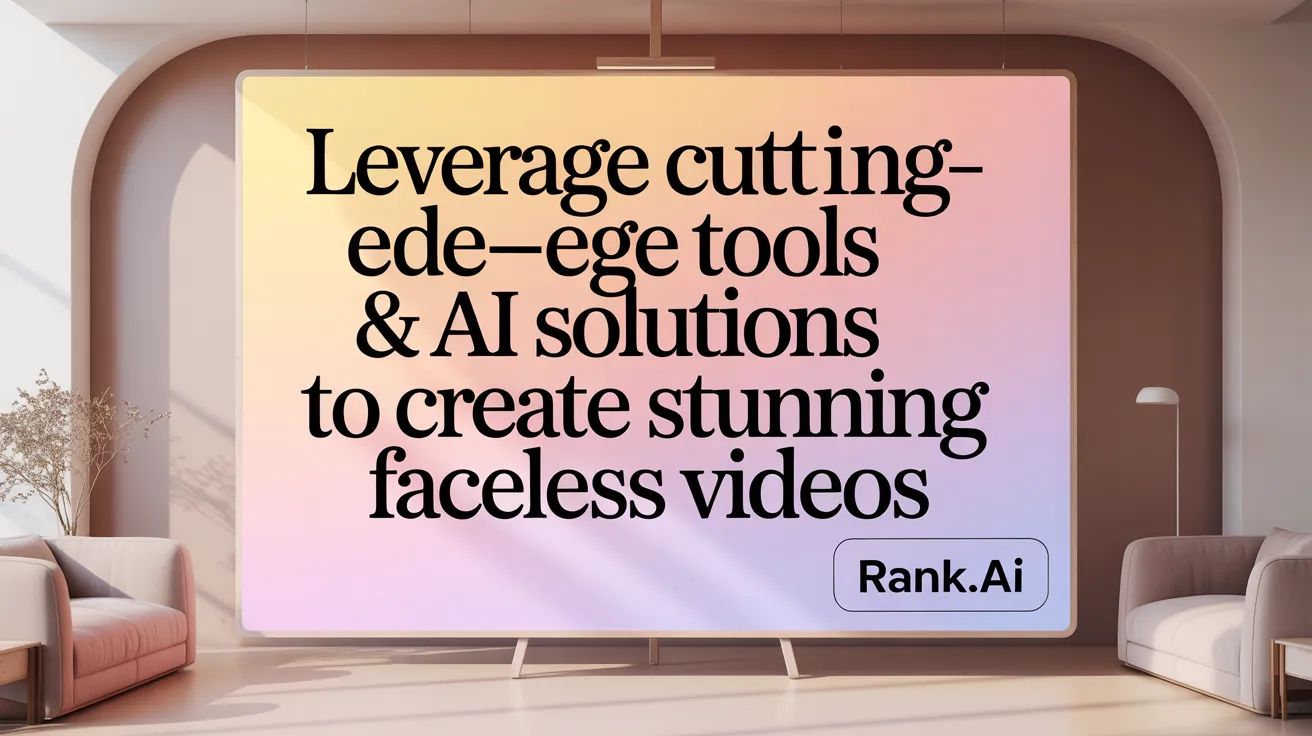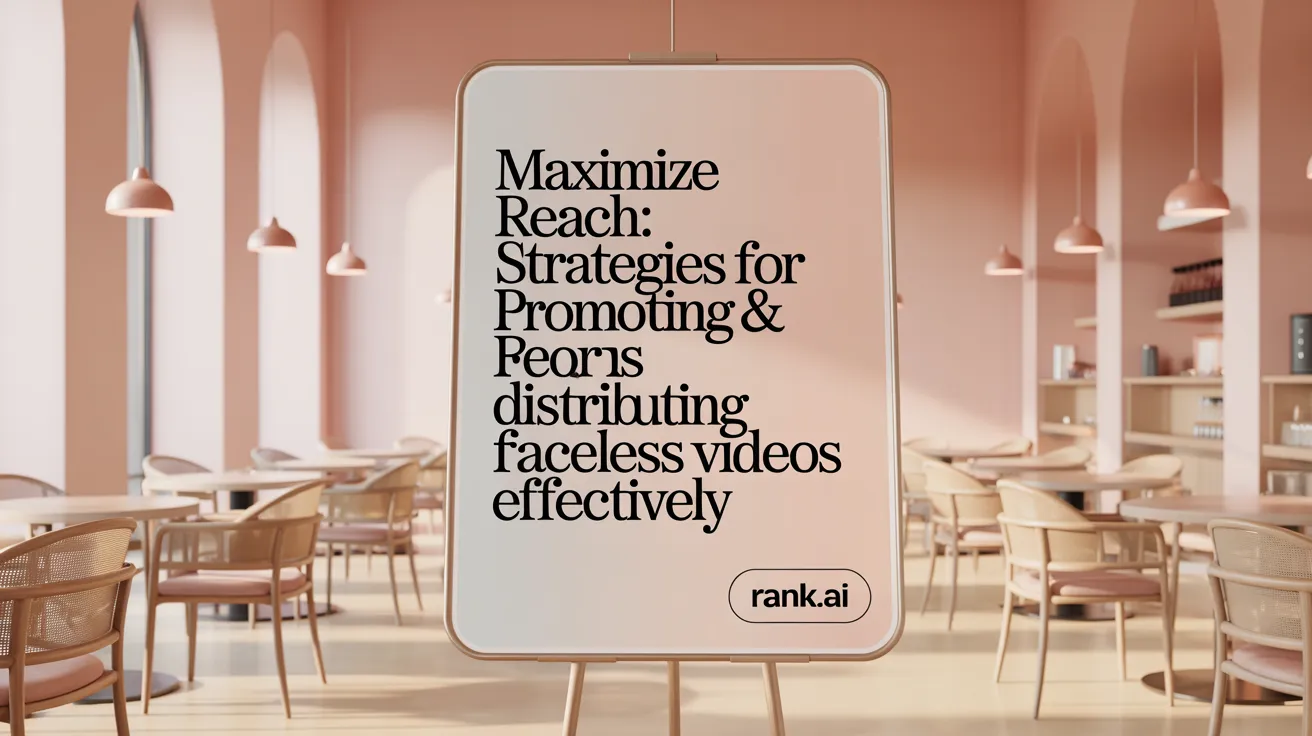Unlocking the Power of Video Marketing Without Personal On-Camera Presence
In today's digital landscape, video marketing stands as one of the most impactful tools for brands and creators alike. Yet, not everyone is comfortable appearing on camera, and many effective strategies exist to engage audiences without personal on-camera appearances. This comprehensive guide explores cutting-edge techniques, tools, and trends to create compelling faceless videos that boost brand awareness, nurture leads, and drive conversions.
Innovative Techniques for Creating Faceless Videos
Creating engaging videos without appearing on camera is entirely possible through a combination of creative techniques and strategic planning. One highly effective method is utilizing voiceovers with AI text-to-speech tools. These advanced AI systems provide natural-sounding narration in multiple languages, allowing creators to produce professional voice narratives without recording their own voice.
Screen recordings are another versatile option, especially useful for demonstrating software, tutorials, or online processes. These videos allow viewers to see exactly what is happening on the screen, making complex steps easier to follow.
Animations and slideshows serve as dynamic options to convey information visually. Whiteboard animations, kinetic typography, and presentation slides can make educational content, product launches, or explainer videos captivating without any face-to-face footage.
Incorporating stock footage and text overlays from online libraries adds production value at a lower cost. Platforms like Pixabay, Unsplash, and Shutterstock provide high-quality clips and images that can be combined seamlessly with custom graphics and animated elements.
Planning is a fundamental step. Conduct keyword research to identify trending topics and craft scripts that resonate with your target audience. Storyboarding helps visualize the flow of the video, ensuring clarity and engagement from start to finish (see video marketing guide).
High-quality audio is essential for professionalism. Using good microphones and editing software like DaVinci Resolve or CapCut enhances sound clarity, while background music and sound effects add depth.
The use of visual assets from stock libraries and animated visuals can make faceless videos more lively and informative. Creating consistent branding elements, like logo overlays and color schemes, helps establish identity.
Finally, successful faceless content relies on regular uploading and optimization. Implement SEO strategies by using relevant keywords in titles, descriptions, and tags. Engaging with your audience through comments and community posts fosters loyalty, expanding your reach and effectiveness. See faceless video content strategies for more details.
With these techniques—ranging from AI voiceovers to strategic planning—you can build a compelling faceless channel that educates, entertains, and drives engagement without ever showing your face.
Popular Faceless Video Formats and Their Marketing Benefits
Faceless videos are an increasingly popular choice for marketers looking to connect with audiences while maintaining privacy or streamlining production. There are several formats that work well for different marketing goals, offering flexibility and engagement.
Animated explainer videos are highly effective for breaking down complex ideas or product features in a simple, engaging way. These videos often use animated characters, icons, and text to tell a story without showing a person on camera, making them ideal for product launches, tutorials, and educational content.
Screen capture tutorials are another popular format, especially for software demonstrations or process walkthroughs. By recording screens while narrating, marketers can teach users how to use tools or complete tasks with visual clarity, avoiding the need for presenters or physical on-camera footage.
Animated infographics combine data visualization with motion graphics to present statistics, comparisons, or processes compellingly. They are especially useful for reports, white papers, or presentations, as they turn static information into dynamic visual stories.
Product demo videos utilizing stock footage or slides are a cost-effective way to showcase products in action. These videos often include high-quality clips or slide shows with voiceovers or captions, effectively highlighting features and benefits without showing the creator.
Whiteboard animations are a classic faceless format where hand-drawn illustrations are animated as the narrator explains key points. They are excellent for educational purposes, onboarding, or explaining complex services simply.
Stop-motion and time-lapse scenes add a creative flair, demonstrating craftsmanship or processes in a visually captivating way. These formats can showcase product assembly, transformations, or a day-in-the-life perspective in an engaging, non-face-to-camera style.
Podcast-style videos, which primarily rely on voice and minimal visuals, can involve static images, animated backgrounds, or simple graphics. They are perfect for interviews, discussions, or storytelling, and appeal to audiences who prefer audio content.
Beyond content types, effective branding and voiceovers elevate faceless videos. Using consistent style, high-quality visuals, branded colors, and clear narration ensures the videos are professional and memorable. Tools like AI voice generators, virtual influencers, and visual enhancement software enable scalable, high-quality production without exposing anyone on camera, as explained in how to create video content without being on camera and faceless YouTube channel ideas.
In summary, these formats provide versatile options for marketers seeking engaging, professional, and privacy-conscious content. The growing trend toward faceless videos reflects technological advances and changing audience preferences, making them a potent tool in modern marketing strategies detailed in video marketing guide and effective video marketing strategies.
Powerful Tools and AI Solutions for Faceless Video Production

Creating engaging videos without showing your face has become more accessible thanks to various innovative tools and artificial intelligence solutions. For more on this topic, see Create videos without showing your face.
For editing videos, professionals often rely on powerful software like Adobe Premiere Pro and Final Cut Pro. These platforms offer advanced editing features to refine footage, add effects, and synchronize audio, providing a professional touch to faceless content. Check out Video Marketing Tools for comprehensive information on such software.
Capturing tutorials, demonstrations, or process videos without appearing on camera is streamlined with screen recording tools such as Camtasia, OBS Studio, and ScreenMagic Pro. These applications enable high-quality recording of your screen activity, making them ideal for software tutorials or step-by-step guides. Related resources include Using Stock Footage and Images and Screen Recording Tutorials.
Animation remains a popular format for faceless videos. Platforms like Powtoon and Animaker allow users to create animated animations, explainer videos, or visual stories easily using drag-and-drop interfaces, pre-made templates, and customizable characters. Learn more at Animated Explainer Videos and Powtoon animated video creation.
AI-powered video creation tools like Lumen5, Pictory, and AnimatoFX have revolutionized the process by converting text, scripts, or articles into engaging videos automatically. These platforms analyze content, suggest visuals, and generate animated scenes, significantly reducing production time. Explore AI video creation tools and AI-Generated Video Content Trends.
Scriptwriting assistance can be obtained through AI tools such as CopyCopter.ai, which help craft compelling narratives tailored for video content, ensuring clarity and engagement. For general video scripting tips, see Video marketing scripting and editing.
To add voiceovers, natural-sounding AI voice synthesis services like VoiceSynth can produce high-quality narration without the need for recording voice clips personally. This enhances accessibility and keeps the content professional. For voiceover and narration ideas, see Voiceover commentary for videos.
Optimizing visibility and scheduling is crucial; tools like TubeMaster assist with SEO to improve search rankings, while social media scheduling platforms like SocialSync help in planning and distributing videos efficiently. Refer to SEO optimization for videos and Scheduling and promoting videos.
By combining these tools, creators can produce impactful faceless videos suitable for marketing, education, or entertainment with ease and efficiency. For broader strategies about faceless or without-face video marketing, see Faceless Video Ideas and Video Marketing Strategy 2025.
Strategic Implementation of Faceless Video Marketing Campaigns
What strategies can be employed to implement effective video marketing campaigns without on-camera appearances?
Implementing successful faceless video marketing campaigns involves a mix of creative visuals, sound, and strategic optimization to effectively engage audiences while maintaining anonymity. One primary approach is leveraging compelling visuals and animations. Using animated explainer videos, kinetic typography, whiteboard animations, or stop-motion can vividly communicate complex ideas and keep viewers interested.
Incorporating voiceovers and stock footage further enhances content quality. High-quality voice narration, whether recorded by professional voice artists or AI-generated, guides the viewer through the story while stock footage adds a professional touch without the need for personal filming. These elements allow brands to produce engaging content efficiently.
Building strong branding without personal presence relies on consistent visual styles, color schemes, and brand messaging embedded in the videos. Using logos, branded color palettes, and thematic design elements helps in establishing recognition and trust.
SEO optimization techniques are critical for increasing visibility. Including relevant keywords in titles, descriptions, and tags, along with adding transcripts and captions, improves search engine rankings. Optimized thumbnails and compelling titles increase click-through rates.
Social media platform strategies should be tailored to each platform’s unique features. Short, attention-grabbing videos perform well on TikTok, Instagram Reels, and YouTube Shorts, while longer, informative videos suit Facebook and LinkedIn. Cross-platform repurposing maximizes reach.
Calls to action (CTAs) are vital in guiding viewers toward desired behaviors such as visiting a website, subscribing, or making a purchase. Clear, concise CTAs embedded within the video or as overlays increase engagement.
Finally, audience-centric storytelling remains essential. Focusing on the viewer's needs, pain points, and interests—delivered through relatable narratives, valuable insights, or educational content—builds trust and fosters lasting connections.
By combining these tactics—creative visuals, strategic SEO, platform-specific content, and compelling CTAs—marketers can execute faceless video campaigns that are both impactful and efficient. This approach allows brands to maintain privacy while still delivering memorable, trusted messages that resonate across diverse audiences.
Best Practices for Designing Engaging Faceless Videos

What best practices ensure the design of engaging, high-quality videos without personal on-camera presence?
Creating captivating faceless videos involves several strategic best practices. First, focus on crafting clear and concise storytelling that captures the viewer’s attention within the first few seconds. High-resolution visuals and professional-quality audio are essential for maintaining viewer engagement and conveying messages effectively.
Utilize tools and techniques such as voiceovers, animations, screen recordings, and stock footage to make your videos dynamic and accessible. These methods allow you to communicate complex ideas visually without needing to appear on camera. Consistent branding—using uniform style elements like colors, fonts, and logos—builds recognition and trust with your audience.
Effective editing plays a crucial role in producing polished content. Incorporate smooth transitions, overlays, and overlays to enhance flow and visual interest. Background music and captions not only add an emotional layer to videos but also improve accessibility for viewers with hearing impairments.
Optimizing your videos for search engines through relevant keywords, tags, and descriptive titles increases discoverability. Maintaining a regular posting schedule helps build momentum and keeps your audience engaged over time.
Additionally, embracing AI-powered tools for scripting, visual creation, and automation can streamline the production process. These technologies allow for efficient scaling of high-quality faceless content, ensuring consistency and professionalism.
By adhering to these practices, content creators can produce engaging, professional, and effective videos that resonate with audiences and reinforce brand identity—even without showing their face.
Efficient Scripting, Editing, and Production of Faceless Videos

Creating engaging faceless videos requires a strategic approach that combines AI technology, effective structuring, and creative visual and audio elements.
One of the first steps is leveraging AI-assisted scriptwriting tools like ChatGPT. These AI models can generate concise, compelling scripts tailored to your topic, saving time and ensuring clarity. Structuring the script within a clear 3-Act Framework—comprising the setup, confrontation, and resolution—helps organize content logically, increasing viewer retention. For guidance, see Faceless Video Ideas and Creating Video Content Without Being On Camera.
For visual content, AI image generators such as Midjourney or Stable Diffusion are invaluable. They can produce high-quality, relevant images and scenes based on detailed prompts, allowing creators to build a visually appealing video without traditional filming. Learn more about visual techniques in Video Marketing Without The Camera.
Automation in editing is made possible with tools like InVideo AI and Visla. These platforms can automatically assemble scenes, incorporate transitions, insert text overlays, and sync visuals with the script, making the editing process faster and more efficient. Check out Video Marketing Tools for AI video creation resources.
Narration plays a crucial role in faceless videos. Using AI voiceover generators that produce natural, emotive speech can replace human voice actors. These tools offer adjustable pacing and tone control, ensuring the narration complements the visuals seamlessly. For narration and voiceover tips, see Using Video in Marketing Without Appearing on Camera.
To keep viewers engaged, insert dynamic visuals every 5-7 seconds. This can include animated texts, icons, infographics, or brief video clips. Balancing these with the narration supports information delivery and prevents viewer fatigue. Tips on effective faceless video engagement can be found in Creative Ways to Shine with Faceless Videos.
Adding appropriate background music enhances emotional engagement. AI music platforms like Strofe can generate custom soundtracks that match the video's tone and pacing, creating a more immersive experience.
Overall, effective faceless video production relies on automation tools, clear scripting, and thoughtful visual and audio design. By dynamically balancing visuals with narration and music, creators can deliver professional-quality content efficiently, even without showing a face. For comprehensive insights, see Ultimate Guide to Video Marketing 2025 and The Complete Guide to Video Marketing.
Creative Content Ideas for Faceless Video Production
Faceless videos open up a broad spectrum of creative possibilities, allowing content creators to craft engaging and versatile visual content without showing their face. One popular approach is animated storytelling and whiteboard explainers. Using tools like Adobe Animate or Doodly, creators can simplify complex concepts into captivating visual narratives that educate and entertain audiences.
Screen recordings are highly effective for tutorials, product demonstrations, or walkthroughs. Recording your software or online processes enables you to deliver clear instructions while focusing on the content rather than personal appearance. Stock footage is another valuable resource; platforms like Pixabay or Videvo offer high-quality clips that can enhance your video’s visual appeal while maintaining a professional look.
Listicles and product reviews are also well-suited for faceless formats. Highlight features, benefits, and comparisons using high-definition shots, overlays, and voiceovers. Meditation guides and educational content have seen rising popularity, especially with calming visuals, voice narration, and serene background music.
To boost viewer engagement, incorporate voiceovers, text overlays, graphics, and captions. These elements create a richer, more accessible experience, ensuring your message resonates regardless of the viewer's viewing situation. High-quality audio, synchronized editing, and compelling visual cues are essential components of successful faceless videos (effective video marketing strategies).
Popular themes that tend to remain evergreen include DIY tutorials, life hacks, motivational stories, industry news, and historical overviews. Trending topics like latest tech updates, viral challenges, or seasonal content can also elevate your channel’s relevance.
Effective promotion and consistent branding help grow faceless channels. Use branded graphics, intros, and outros, and share your videos across multiple platforms such as YouTube, social media, and websites. By mixing creative formats with strategic marketing (effective video marketing strategy), you can maximize your reach and build a loyal audience — all without ever stepping in front of the camera.
Measuring and Optimizing the Impact of Faceless Video Campaigns
Faceless video marketing has become a popular strategy for brands and content creators looking to engage audiences effectively without showing their face. To ensure these campaigns are successful, it is crucial to carefully measure their performance and refine future efforts.
One of the primary ways to gauge success is through quantitative metrics. View counts reveal how many people have watched the video. Engagement metrics—such as likes, comments, and shares—indicate how actively viewers are interacting with the content. Click-through rates (CTR) measure how many viewers took the desired action after watching, while conversion rates show how many completed a specific goal, such as signing up for a newsletter or purchasing a product.
Audience retention analysis is equally important. This examines how long viewers watch the video and where drop-offs occur, providing insight into which parts are most engaging or need improvement.
In addition to numbers, qualitative feedback offers valuable perspectives. Comments, direct messages, and survey responses can reveal viewers’ opinions, preferences, and suggestions, helping to refine messaging and format.
To optimize campaigns, marketers should experiment with different types of faceless videos—animated explainer videos, AI avatars, stock footage compilations, or voiceover-driven content. Testing various calls to action (CTAs) and video formats allows for identifying the most effective strategies.
Leveraging analytics platforms such as YouTube Analytics, Facebook Insights, or specialized ad network reports provides detailed data on viewer behavior and engagement patterns. These tools help track performance over time and assess the impact of specific content adjustments.
Finally, continual content refinement based on data is essential. For example, if audience retention drops significantly at a certain point, that segment can be reworked to be more engaging. Similarly, styles and formats that yield the highest engagement numbers should be prioritized.
By systematically analyzing these metrics and insights, brands can fine-tune their faceless video campaigns, improve viewer connection, and achieve better marketing outcomes with optimized resource use. For comprehensive information on effective video marketing strategies and faceless video ideas, see these resources.
Emerging Trends and Innovations in Faceless Video Marketing

What are the current trends and innovative approaches in video marketing that do not require on-camera appearances?
The landscape of faceless video marketing is experiencing rapid growth, with industry reports indicating an expected increase of around 125% in such content over the next two years. This prevalent trend is fueled by the scalability of creating high-quality videos without personal appearances, making it a favored choice for brands seeking efficiency and broad platform compatibility.
One of the most exciting developments is the integration of AI technology, which powers storytelling through virtual influencers—digital personas that engage audiences authentically while remaining entirely on-screen. These AI-driven entities, along with text-to-video tools, enable the rapid production of diverse content in multiple languages, expanding global reach and accessibility.
Cinematic styles are increasingly utilized through stock footage mashups that produce visually captivating narratives. Popular formats in 2025 include Tiny Workers animations—short, playful clips conveying complex ideas with simple graphics—and loopable ASMR videos, which are used for relaxation and mood-setting. Additionally, mini-world scenarios—tiny, animated universes—are crafted to draw viewers into immersive environments without revealing creator identities.
The focus on authenticity remains vital; videos crafted with AI and automation tech emphasize message clarity and brand voice over personal visibility. This approach not only fosters trust but also exceeds expectations for scalability, allowing brands to produce a high volume of engaging, multilingual content efficiently.
Overall, innovative faceless video strategies prioritize quality, storytelling, and messaging, transforming digital content creation in 2025 and offering versatile, impactful marketing solutions that align with the future of digital engagement.
Overcoming Camera Shyness and Building Confidence for Video Marketing
Many individuals feel uneasy about appearing on camera, which can hinder their ability to create engaging marketing videos. Fortunately, there are strategies to help reduce this anxiety and boost confidence.
One effective approach is explaining the video creation process clearly. When participants understand that their role is primarily to communicate a message, and that editing can enhance their presentation, they often feel more comfortable. Reassuring interviewees that they don’t need to be perfect or constantly on camera can alleviate pressure.
Providing positive feedback and encouragement is crucial. Complimenting participants on their appearance and contributions helps reinforce their confidence. A producer’s confident demeanor also sets a positive tone. When the person behind the camera exudes self-assurance, it tends to influence shy individuals to relax and perform better.
Engaging those who are initially resistant is essential. Patience and gentle encouragement can turn hesitant participants into valuable contributors. Over time, their comfort level naturally increases.
For those still uncomfortable, alternative faceless video methods are excellent options. Using voiceovers, animations, screen recordings, or stock footage allows creators to deliver impactful content without appearing on camera. These techniques can be just as powerful, enabling consistent communication while respecting personal boundaries.
In summary, combining transparent communication, positive reinforcement, confident leadership, and creative faceless formats creates a supportive environment. This fosters confidence and encourages even the most camera-shy individuals to produce compelling marketing videos.
Leveraging Various Content Ideas for Faceless Video Creativity
Unboxing and Process Videos
Unboxing videos offer a simple yet effective way to showcase packaging quality, branding touches, and the care put into products. These videos can build trust by highlighting the unboxing experience without needing to appear on camera (Faceless videos for print shop owners). Additionally, process videos that demonstrate printing, craftsmanship, or assembly techniques help illustrate your skills and build credibility. Time-lapse content condenses hours of work into engaging clips, effectively showcasing productivity and effort (Faceless Video Ideas).
Behind-the-Scenes and Time-Lapse Content
Sharing behind-the-scenes moments or creating time-lapse videos offers viewers an exclusive peek into your daily operations or special projects. These styles foster transparency and connection, engaging audiences without showing faces (Non-Face Video Content Ideas). They are quick to produce and visually appealing, making them popular among businesses wanting to build authenticity.
Tech Demonstrations and Screen-Sharing Tutorials
Demos of new equipment, software, or techniques can be created through screen recordings or videos that focus on the tool or process rather than on individuals. Screen sharing is especially popular for educational or software tutorials, allowing creators to instruct effectively while remaining faceless (Creating Screen Recording Tutorials, Screen Recording Tutorials, Loom screen and camera recording).
Voiceovers and Commentary
Voiceover narrations add context and personality to videos without revealing anyone’s face. This method is ideal for product reviews, tutorials, or storytelling, providing flexibility and privacy (Voiceover commentary for videos). Quality audio equipment and scripting ensure your message remains clear and engaging (Video Editing and Branding).
Immersive POV and Creative Content
Point-of-view (POV) videos put viewers in the action, increasing engagement through immersion. Often using devices like GoPro, these videos showcase tasks or experiences from the creator’s perspective—perfect for demonstrating processes or exploring environments (POV Video Techniques). Combined with narration or background music, POV content makes your videos dynamic and compelling (Engaging Video Types without Face Exposure).
Effective Promotion and Distribution of Faceless Videos Across Platforms

How can I effectively repurpose faceless videos for social media, email, and website embedding?
Repurposing faceless videos involves adapting the same content for various formats and platforms to maximize reach. For social media, shorten videos to fit platform-specific length limits—ideally under 60 seconds for TikTok, Reels, and Shorts—and add captions to cater to viewers watching without sound. Embedding these videos into emails can boost engagement; include a clear call-to-action and make sure the videos are optimized for email client compatibility.
On websites, incorporate videos within product pages, tutorials, or FAQs to enhance user experience. Use large, visible play buttons and ensure your videos are optimized for fast loading. Combining different video snippets into compilation reels or highlight summaries also helps keep your audience engaged across channels (Effective Video Marketing Strategies).
Why is platform-specific format optimization important?
Different platforms have unique requirements for video size, aspect ratio, and content style. For example, vertical videos (9:16) perform best on TikTok, Instagram Reels, and Shorts, while horizontal (16:9) is suitable for YouTube and embedded website videos.
Optimizing videos for each platform ensures they display correctly and are more likely to engage viewers. It also improves algorithm ranking, increasing organic reach. Customizing thumbnails, adding platform-relevant hashtags, and tailoring upload timing further enhance visibility (Video Marketing Strategy 2025).
How does consistency and scheduling boost faceless video promotion?
Consistent posting helps build trust and keeps your brand top-of-mind. Develop a content calendar to schedule regular uploads, aligning with audience activity patterns. Use scheduling tools to automate posting, ensuring your videos go live at optimal times—when your audience is most active (7 steps to successful social media video marketing).
Regular uploads also improve your channel or profile’s algorithm ranking, attracting more organic viewers over time. Consistency emphasizes professionalism and dedication, fostering follower loyalty (Video marketing strategies).
What are effective SEO strategies, including keyword optimization?
Incorporate relevant keywords into your video titles, descriptions, and tags to improve search discoverability. Use tools like Google Keyword Planner to identify popular search terms and include them naturally. For faceless videos, adding detailed captions and transcripts also boosts SEO, making your content accessible and indexable (Video marketing guide).
Thumbnails, video metadata, and structured data enhance search engine rankings. Embedding videos on your website with optimized content further increases visibility (Video SEO techniques).
How can collaborations and influencer marketing amplify my faceless videos?
Partnering with influencers or industry experts can expand your reach. Collaborate on videos or have influencers share your content to tap into their established audiences. Influencers can promote faceless videos through shout-outs or guest appearances—using voiceovers or overlays without showing their faces (Using video in marketing without appearing on camera).
Joint efforts increase credibility, foster trust, and generate backlinks, which are beneficial for SEO. Consistent influencer collaborations also help establish your brand authority (Faceless Video Ideas).
Why are analytics crucial for targeting and improving faceless video promotion?
Analyzing metrics such as view counts, engagement rates, watch time, and audience retention allows you to understand what resonates. Use platform-specific analytics tools (e.g., YouTube Analytics, Facebook Insights) to gather insights (Measuring Video Marketing Success).
Adjust your content strategy based on these findings. For example, if certain topics or formats perform better, focus on producing similar content. Data-driven targeting helps you refine audience segmentation and improve the effectiveness of your marketing efforts (Video Marketing Analytics Platforms).
Art of Storytelling and Emotional Connection Without On-Camera Presence
Using Visual Storytelling Techniques
Faceless videos excel at crafting compelling stories through impactful visuals alone. Using animation, stock footage, or motion graphics, creators can depict scenarios, emotions, and narratives that resonate with viewers. Effective visual storytelling often involves clear framing, symbolism, and visual metaphors that communicate messages without words.
Engaging Narration and Voiceovers
A captivating voiceover guides viewers through the story, adding personality and tone that evoke emotions. High-quality narration combined with suitable audio effects can make simple visuals stand out, turning an otherwise plain video into an engaging experience. Learn more about voiceover commentary and narration in faceless videos.
Incorporating Brand Elements to Foster Trust
Consistent branding—using logos, brand colors, and style—builds familiarity and trust. Customized intros, outros, and overlays reinforce branding messages, making viewers associate these visuals with quality and credibility. See best practices for branding in video marketing to elevate your faceless videos.
Emotional Appeal Through Music and Pacing
Music influences the mood of the video, strengthening emotional connections. Upbeat tunes energize, while softer melodies evoke warmth or nostalgia. Fast-paced editing creates excitement or urgency, whereas slower sequences foster reflection. Find tips on creating engaging video content with effective pacing and audio.
Captions and Text Overlays to Enhance Communication
Text overlays and captions ensure your message is accessible and clear, especially on mute but also to reinforce key points. They help emphasize calls to action or important information, guiding viewers seamlessly through the story. Explore text-overlay storytelling and caption use in faceless videos.
Building Community Through Authentic Content
Authentic storytelling, reflecting genuine experiences and values, fosters a sense of community. Sharing behind-the-scenes glimpses, customer stories, or industry insights creates loyalty and encourages engagement—without the need to appear on camera. Learn how to build community and engagement with authentic faceless video content.
By leveraging these storytelling techniques, brands can create faceless videos that not only inform but also emotionally connect with audiences, enhancing trust and loyalty. For a comprehensive guide to video marketing strategies that include faceless video content, explore further resources.
Embracing Faceless Video Marketing for Future Success
Faceless video marketing presents a powerful, versatile avenue for brands and creators to connect with their audiences without requiring on-camera appearances. By integrating diverse formats like animations, screen recordings, and AI-driven tools, marketers can craft engaging content that respects privacy while maintaining high quality and strong branding. Innovations such as AI-powered production and multilingual capabilities are propelling faceless video strategies to the forefront of digital marketing in 2025 and beyond. Ultimately, mastering faceless video creation and promotion unlocks broader reach, improved engagement, and substantial competitive advantages in an increasingly video-centric world.



